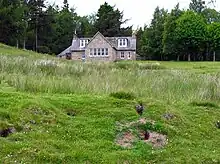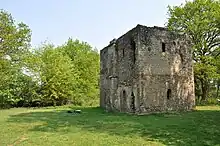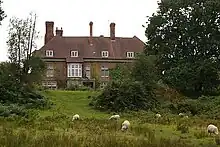Sporting Lodge
In Great Britain and Ireland a sporting lodge – also known as a hunting lodge, hunting box, fishing hut, shooting box or shooting lodge – is a building designed to provide lodging for those practicing the sports of hunting, shooting, fishing, stalking, falconry, coursing and other similar rural sporting pursuits.

In a more modern context, they sometimes form the principle residence at the centre of a Sporting Estate[1][2]
History
Sporting lodges date back to the Norman era of British history where after the Norman Conquest the King divided up land for himself and favoured nobles on which to hunt. This could be a Royal Forest or a Chase. The word Lodge is derived from a Frankish or Norman word for 'shelter', and the earliest examples would have been built in these lands to serve as accommodation for the King and his guests. The lodges would also often serve as accommodation for the King's staff whose job was to protect the land and game or quarry from poachers, and later to enforce law and order within the forest.[3][4]

The earliest examples of these lodges are often 'Warreners Lodge's'. The Normans were fond of hunting rabbits, which were not native to the British isles, and so they introduced them. However the rabbits were ill-adapted to the English climate and easy prey for native predators, so purpose built artificial 'warrens' were established and fenced in, usually on poor, sandy or heath land. As the rabbits commanded a high value, lodges were built for 'warreners' - people employed to guard and care for the rabbits.[5]
During the late medieval period as more land was enclosed and "emparked", hunting rights became more socially important and so too did the role of the lodge. Introduced by William I, "Forest law", was historically distinct from the law of the rest of the country and operated outside the common law, serving to protect game animals and their forest habitat from destruction. Under the Anglo-Saxon kings, officers had been appointed across the country to oversee areas of food and forestry, especially where there may be geographic or natural dangers such as the "Wardwicks of the Moors", and the Norman kings continued this practice, appointing 'Wardens', 'Keepers', or 'Guardians' of their forests. Lodges would be provided for these officials, for example Rushmore Lodge which was provided as the residence of the Keeper of Cranborne Chase. These Wardens would host and attend courts known as Eyre's, where they would receive rents, fines and equipage (e.g. saddle, bridle, sword and horn). The forest law was enforced locally by "Woodwards" and their deputies, called "Rangers", with offences adjudicated on by Justices in eyre, while "Agisters" managed the free-roaming animals, and "Verderers" investigated and recorded minor offences such as the taking of venison and the illegal cutting of woodland, and dealt with the day-to-day forest administration. The five animals of the forest protected by forest law (outlined by John Manwood a Justice Eyre of the New Forest) were the hart and hind (red deer), boar, hare and wolf. Protection was also said to be extended to the beasts of chase, the buck and doe (fallow deer), fox, marten, and roe deer, and the beasts and fowls of warren: the hare, coney, pheasant, and partridge. White Park cattle, such as the Wild Cattle of Chillingham were also hunted. As the courts would meet at the lodges, depending on the workload of the court, they were often converted into full time offices and court houses for the officials required to oversee and uphold forest law. Speech House in the Forest of Dean began life as a hunting lodge for Charles II but was later re-commissioned to host the "Court of the Speech", a sort of parliament for the Verderers and Free Miners managing the forest, game, and mineral resources of the area. [6][7][8][9][10]
Royal hunting lodges from across the late medieval era can be found across England, for example in the grounds of Kings Langley Palace (dating to Henry III), to John O'Gaunt's Castle (dated to the era of Edward III).
Falconry was also an important form of hunting enjoyed by Royals in both England and Scotland. A Royal Mews (a birdhouse designed to house one or more birds of prey) was established in Charing Cross in London in the reign of Edward I, and officers were appointed to organise hawking, such as the Hereditary Grand Falconer of England and the Hereditary Royal Falconer of Scotland. The mews at Charing Cross provided lodging for the Kings falconers. By the 1530s the Mews had been converted into a stable for the Kings horses with lodging for carriage drivers and groomsmen, which is why the royal stables are now known as the Royal Mews. The head of the Royal Mews is the Master of the Horse with all matters connected with horses and formerly also the hunting hounds of the sovereign, as well as the stables and coachhouses, the stud, mews and previously the kennels, within their jurisdiction. Officials responsible for the kings hunting dogs - such as the Master of the Buckhounds and Master of the Staghounds - sat within his department.[11]
Hunting remained an important Royal pastime into the Tudor era, and having access to it, as well as a lodge in which to host and entertain, could elevate ones social status. King Henry VIII for example, stayed at Savernake forest in 1535, where it is believed that his eye was then taken by his host's daughter, Jane Seymour. The host was the Kings Warden of the Forest of Savernake Sir John Seymour. After the execution of Anne Boleyn in May 1536, they were subsequently married, and Jane was crowned Queen just months later, causing the head of the family at Savernake to suddenly find himself father-in-law to Henry VIII. Savernake remains to this day (2023) the only Royal forest still in private hands with David Brudenell-Bruce, Earl of Cardigan serving as the current and thirty-first warden of Savernake Forest. In 1543, Henry commissioned a building, known as Great Standing, from which to view the chase at Chingford. The building was renovated in 1589 for Queen Elizabeth I and can still be seen today in Chingford. The building is now known as Queen Elizabeth's Hunting Lodge, and is open to the public. [12][13][14]
See Also
References
- Hobson, J.C. Jeremy (2013). Sporting Lodges. Shrewsbury, U.K.: Quiller Publishing, Limited. ISBN 978 1 84689168 7.
- https://www.scottscastles.com/sporting-lodges-in-scotland/
- Hobson, J.C. Jeremy (2013). Sporting Lodges. Shrewsbury, U.K.: Quiller Publishing, Limited. pp. 13–14. ISBN 978 1 84689168 7.
- https://www.scottscastles.com/sporting-lodges-in-scotland/
- https://www.english-heritage.org.uk/visit/places/thetford-warren-lodge/history/rabbits-warreners/
- Hobson, J.C. Jeremy (2013). Sporting Lodges. Shrewsbury, U.K.: Quiller Publishing, Limited. pp. 13–14. ISBN 978 1 84689168 7.
- https://www.scottscastles.com/sporting-lodges-in-scotland/
- https://www.theguardian.com/environment/2023/mar/26/chillingham-northumberland-wild-cattle
- https://en.mogaznews.com/World-News/1167328/Sir-Benjamin-Slade-sells-Englands-largest-nature-reserve-Maunsel-House-for-.html
- https://www.verderers.org.uk/verderers-court/
- https://www.british-history.ac.uk/survey-london/vol20/pt3/pp7-14
- Bruce, Alistair (2003). Keepers of the Kingdom. London, U.K.: Cassell Illustrated. p. 44. ISBN 0 30 436201 8.
- https://www.theguardian.com/environment/2023/mar/26/chillingham-northumberland-wild-cattle
- https://en.mogaznews.com/World-News/1167328/Sir-Benjamin-Slade-sells-Englands-largest-nature-reserve-Maunsel-House-for-.html
.jpg.webp)
